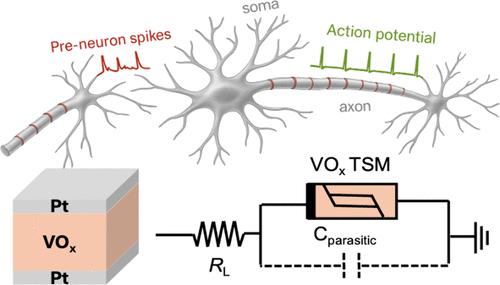Thermally Activated Negative Differential Resistance VOx Memristor with Switchable Rate and Leaky Integrate-and-Fire Spiking Dynamics
IF 16
1区 材料科学
Q1 CHEMISTRY, MULTIDISCIPLINARY
引用次数: 0
Abstract
Spiking neural networks (SNNs) require neuron devices that are both compact and capable of supporting continuous-time and event-based dynamics. Here, we demonstrate a VOx-based threshold switching memristor (TSM) that intrinsically enables dual-mode operation, functioning as both a spiking encoder and a leaky integrate-and-fire (LIF) neuron. While such dual behavior is theoretically possible in volatile memristors, it has only been experimentally demonstrated in limited cases. It is achieved intrinsically in a single VOx-based device, arising from a thermally driven insulator-to-metal transition (IMT) within the VOx layer, confirmed by temperature-dependent XRD and correlated with snap-back negative differential resistance (NDR) observed in electrical measurements. Integrated into a passive circuit, the device generates high-frequency spike trains under analog input and tunable LIF responses under pulsed stimulation. The device achieves a maximum spiking frequency of 570 kHz, a time-to-first-spike (TTFS) of 1.6 μs, and energy consumption as low as 4.7 nJ per spike. These results highlight the strong coupling between structural phase dynamics and neuronal functions, positioning the VOx TSM as a promising platform for scalable neuromorphic hardware with biologically realistic spiking capabilities.

热激活负差分电阻VOx忆阻器,具有可切换速率和泄漏集成和火焰尖峰动力学
尖峰神经网络(snn)要求神经元设备既紧凑又能够支持连续时间和基于事件的动态。在这里,我们展示了一种基于vox的阈值开关忆阻器(TSM),它本质上支持双模式操作,既可以作为尖峰编码器,也可以作为泄漏集成和触发(LIF)神经元。虽然这种双重行为在理论上是可能的易失性忆阻器,但它只在有限的情况下被实验证明。它本质上是在一个基于VOx的器件中实现的,由VOx层内的热驱动绝缘体到金属转变(IMT)产生,由温度相关的XRD证实,并与电测量中观察到的回跳负差分电阻(NDR)相关。该器件集成到无源电路中,在模拟输入下产生高频尖峰串,在脉冲刺激下产生可调谐的LIF响应。该器件最大峰值频率为570 kHz, TTFS (time-to-first spike)为1.6 μs,能耗低至4.7 nJ / spike。这些结果强调了结构相动力学和神经元功能之间的强耦合,将VOx TSM定位为具有生物学逼真峰值能力的可扩展神经形态硬件的有前途的平台。
本文章由计算机程序翻译,如有差异,请以英文原文为准。
求助全文
约1分钟内获得全文
求助全文
来源期刊

ACS Nano
工程技术-材料科学:综合
CiteScore
26.00
自引率
4.10%
发文量
1627
审稿时长
1.7 months
期刊介绍:
ACS Nano, published monthly, serves as an international forum for comprehensive articles on nanoscience and nanotechnology research at the intersections of chemistry, biology, materials science, physics, and engineering. The journal fosters communication among scientists in these communities, facilitating collaboration, new research opportunities, and advancements through discoveries. ACS Nano covers synthesis, assembly, characterization, theory, and simulation of nanostructures, nanobiotechnology, nanofabrication, methods and tools for nanoscience and nanotechnology, and self- and directed-assembly. Alongside original research articles, it offers thorough reviews, perspectives on cutting-edge research, and discussions envisioning the future of nanoscience and nanotechnology.
 求助内容:
求助内容: 应助结果提醒方式:
应助结果提醒方式:


